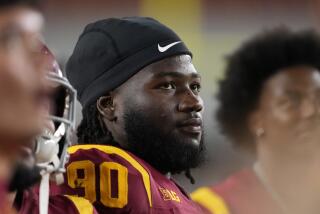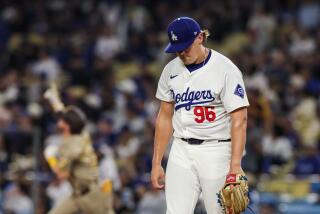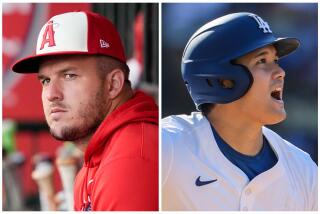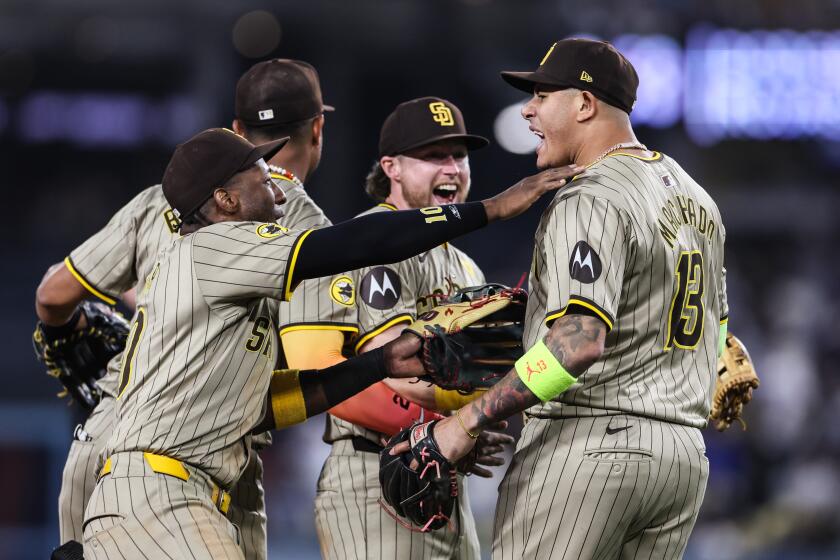Horse Racing’s Manfusos: From Backstretch to the Front Office
Frank De Francis is the focus of most stories concerning Maryland’s thoroughbred tracks. The president of Laurel and Pimlico is dynamic, innovative and his accessibility extends his visibility.
But De Francis’ behind-the-scenes associates -- headed by minority partners Bob and Tom Manfuso -- have played significant roles in patterning the resurgence of Maryland racing.
“Our relationship is one of almost family,” De Francis said. “They give me the benefit of their opinions and their views. We don’t always agree. They don’t pretend I’m always right, nor do they back away from every issue. But they give me the respect to make the decisions for this organization.”
John A. “Tom” Manfuso Jr. actually retired in 1979, when Burton Parsons Pharmaceutical, the company his father had purchased 31 years before, was sold for more than $100 million. Tom, who had served as the company’s vice president-general manager, headed south to enact major decisions regarding golf-club selection on Florida’s fairways.
Bob Manfuso, who had been Burton Parsons’ marketing and sales director, turned his attention to a product that had fascinated him and brother Tom since their childhood days in Chevy Chase, Md. -- the Maryland thoroughbred. Bob owned and bred them, and late in 1984 he was elected president of the Horsemen’s Benevolent and Protective Association.
Bob’s tenure lasted only 10 days. He resigned in early December to purchase Laurel Race Course with De Francis and brother Tom, who had grown weary of abundant leisure.
Soon after the purchase of Laurel -- a few days before Christmas 1984 -- the doorbell rang at Tom Manfuso’s Chevy Chase home at about 2 a.m. Outside stood a policeman and a minister who told the Manfusos that their 21-year-old son, Thomas Allen Manfuso, had been killed in a car accident.
Tom, still pierced by the loss, spoke little of the incident. “You never recover. You just learn to handle it better,” he said. “When you have something like that happen, the best therapy is to get busy and stay active. The purchase of Laurel was a godsend for me, something I could throw myself into.”
The Maryland racing industry was in need of such attention. Attendance and handle were stagnant and the state’s takeout was high, stifling purse growth. Horsemen defected and fans lost interest, the esthetics of Bowie, Laurel and Pimlico reflecting the industry’s paralyzed state.
“I loved horses, I loved the racing, I loved the backstretch,” Bob Manfuso said. “I knew that Maryland racing was in trouble, and I knew that we were rapidly deteriorating to a very mediocre product in terms of the sport. It became very clear to me that someone was going to have to buy one of these mile race tracks if Maryland were ever to move forward.”
Vice president-executive secretary of Laurel and Pimlico, Bob Manfuso is in charge of the tracks’ racing operations, determining the overall quality of the racing stock and structuring stakes programs. The industry’s improved health in recent years has brought added challenge to Manfuso’s job; fattened purses have enticed out-of-state horsemen, placing a premium on stall space.
As vice president-secretary, Tom Manfuso is responsible for the physical plant, its modifications and maintenance. He is overseeing construction of Pimlico’s Sports Palace, scheduled for completion before the track reopens in March, and has been negotiating with harness-track owner Mark Vogel regarding Laurel-Pimlico simulcasts to Delmarva Downs, the harness track near Ocean City, Md.
Bob and Tom Manfuso look nothing alike. Tom, eight years older at age 59, is taller, broader, darker complexioned. He scarcely moves his lips when he speaks in raspy baritone, and he wears conservative business suits and eyeglasses that get darker in sunlight. Bob dons tweed and khaki and maybe an argyle sweater. His hair is curlier and much lighter than Tom’s, his features finer. His voice is deep and clear.
Bob Manfuso had gotten to know De Francis by helping him syndicate the stallion Hail Emperor, and he approached De Francis about the possible purchase of Laurel. De Francis, who had revived the troubled Freestate Raceway, said he would be interested, providing he gain controlling interest. The deal was made, although De Francis did not actively participate in direct negotiations. He resigned as Maryland secretary of economic and community development, and one of racing’s most daring, imaginative and profitable management teams was assembled.
Until then, track ownership had been the only aspect of thoroughbred racing untouched by the Manfuso family. John Manfuso Sr. began breeding and racing horses in the 1930s, and he would take his sons to the track to watch morning workouts and the mechanics of the backstretch. Exposure to afternoon races would come much later.
“He was funny that way,” Bob said of his father. “The morning was one thing. I remember vividly Thanksgiving and Christmas in those days, when he used to buy full-dressed hogs and give them to whoever was training for him, the backstretch help, and we always went with him as a traditional kind of thing. But you never went to the races with him in the afternoon. I think I snuck out a couple of times on my own, but you didn’t come with him until you were 14 or 15.”
“The tough part about it was that we’d had exposure to the horses he’d bred, and the exciting times in the morning when they’d work,” said Tom. “Obviously, you’d like to see what they could do in the afternoon. It was a natural curiosity for a kid to have.”
Tom carefully followed the career of Aneroid, a sore-legged yearling his father bought at an auction in Upperville, Va., and who later defeated the renowned Seabiscuit.
As Tom entered Landon School in Bethesda, Md., his interests shifted toward team sports, but young Bob soon began tagging along with his father. “Bobby, as far as horses were concerned, had a more acute interest than Tommy,” John Manfuso Sr. said. “As Tommy got older, suddenly it was football, tennis, basketball.”
Tom was an all-New England tackle at Bowdoin College, where during his junior year he determined his career objective. “We were playing Williams, and my dad called and said he’d like to see me in New York after the game,” Tom said. “He told me he was considering purchasing a pharmaceutical company, and would I be interested in participating. I told him that excited me, and I was very anxious to go in with him.”
He began after serving two years in the Korean War. Bob joined the family operation after graduating from Princeton.
The growth of his business did not limit John Manfuso Sr.’s outside interests. “Even then,” son Tom said, “he devoted a tremendous amount of time to the horsemen’s association.”
John Manfuso Sr. was a longtime national president of the HBPA. Always a horsemen’s advocate, he remained a backstretch sentry of sorts even after his sons and De Francis purchased Laurel, then Bowie and Pimlico.
“I won’t hesitate to criticize them on the race track, particularly about the backstretch part of things,” John, 85, said. “But they haven’t given me too much to squawk about.”
Tom and Bob Manfuso said they consider themselves horsemen first and foremost. With George and Jeff Huguely they established Fourbros Stables in 1974. Investing $2,500 apiece, they bought a 2-year-old filly named Crackerfax for $8,000 and a yearling for $2,000.
“What intrigued me about (Crackerfax) at the time was that my father stood Salt Spray, and Crackerfax’s dam had produced a couple of very solid runners,” Bob Manfuso said. “I was prejudiced, but I thought Salt Spray had the touch for being a very useful stud.”
The stable quickly prospered. Crackerfax went on to win two stakes races and $129,019, and two years later Fourbros struck again. They paid $14,500 for a yearling son of Tentam at a Timonium sale.
The colt was Shelter Half, a multiple stakes winner who earned $236,337 before retiring in 1980. He was syndicated and stands at Glade Valley Farm in Frederick, Md., Fourbros retaining 10 stallion shares.
Then emerged Green Book, who rose to prominence as a 3 year old in 1987 and became Fourbros’ most recent stakes winner. As Green Book was preparing to return to the races last spring, he developed a slab fracture and was sidelined for the year. He’s back in training now and is expected to soon resume his career at age 5.
Bob and Tom Manfuso also have racing and breeding interests separate from Fourbros. Their partnership with Frank De Francis -- himself a thoroughbred owner and breeder -- thus created a management team well versed as to the interests and concerns of horsemen.
More to Read
Go beyond the scoreboard
Get the latest on L.A.'s teams in the daily Sports Report newsletter.
You may occasionally receive promotional content from the Los Angeles Times.










